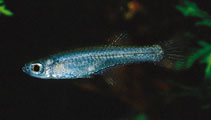| Family: |
Procatopodidae (African lampeyes), subfamily: Procatopodinae |
| Max. size: |
4 cm TL (male/unsexed); 2.5 cm TL (female) |
| Environment: |
benthopelagic; freshwater; pH range: 5.80000019073486 - 7.19999980926514, non-migratory |
| Distribution: |
Africa: along coast from southwestern Nigeria eastward across Niger River delta to border with Cameroon (Ref. 57259); lower Lomé and Kienke drainages in southwestern Cameroon (Ref. 3788); and Rio Utonde and Rio Benito drainages in Equatorial Guinea (Ref. 3788). |
| Diagnosis: |
Dorsal spines (total): 0-0; Dorsal soft rays (total): 6-8; Anal spines: 0-0; Anal soft rays: 12-14. Diagnosis: Small ‘Lampeye’ with relatively long fins; dorsal, anal and caudal fins of the male trapezoid, upper lobe of caudal fin enlarged; ventral fins with extremely long second and third rays that may reach to the caudal fin base; dorsal-fin with 6-8 rays, anal fin with 12-14 rays; first dorsal fin ray above or just behind last anal fin ray; scales on mid-longitudinal series 24-27 (Ref. 57259).
Colouration: Male colouration: body is yellow-grey to pale olive, the ventral area being silver; the sides with a light blue iridescence of dust fine spots; the iridescence is most intense on the anterior part of the side; iridescent spots not arranged in horizontal lines or bands; scales on the back and the upper parts of the sides with a narrow dark grey margin, producing a weak reticulation; dorsal fin is very pale yellow to transparent with rows of dark red-brown spots; anal fin very pale yellow to transparent with horizontal rows of dark red-brown spots; the caudal fin is pale yellow with curved rows of dark red spots; two colour phenotypes can be identified, a white and an orange, according to the colour of the margins at the dorsal and anal fin, upper and lower caudal fin and the colour of the extended ventral fins; in the adult male the ventral fins may extend to the end of the caudal peduncle (Ref. 57259). Female colouration: translucent pale grey with silver abdominal region; some small golden spots may be present on the sides, usually on or near the mid-lateral line; scales on the sides have very narrow grey edgings; all fins are colourless, ventral fins not extended (Ref. 57259). Both sexes have a distinct reflective blue spot in the upper part of the iris (Ref. 57259). |
| Biology: |
Found in rivers and brooks, mostly in weedy areas and under forest cover in river drainages (Ref. 3788); also brackish water, river mouths, lagoons and estuaries along the coast (Ref. 57259). Not a seasonal killifish. Is very difficult to maintain in aquarium (Ref. 27139). |
| IUCN Red List Status: |
Least Concern (LC); Date assessed: 12 September 2019 Ref. (130435)
|
| Threat to humans: |
harmless |
Source and more info: www.fishbase.org. For personal, classroom, and other internal use only. Not for publication.

